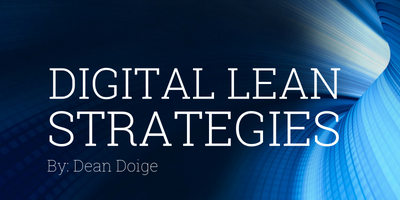By Dean Doige
This is part 1 in a series of blogs on Lean Principles and their alignment with Digital Transformation.
I was given the opportunity to speak at the CAMSS Alberta conference recently held in Calgary. When contemplating what topic to speak on, I thought the interrelated concepts of digital and Lean IT would be of interest.
This blog is the first in a series of six articles that show how lean principles support the journey towards digital transformation. Lean methodology was born out of the Toyota Production System which started development in 1948. I like to define Lean as “Continuous improvement in the pursuit of perfection”. It is based on the principles of Customer Value, Value Stream, Flow, Pull, and Perfection”.
As IT leaders, we are constantly bombarded with the hype of digital transformation and digital business. Though there are many great examples of digital businesses such as Uber, Amazon, Google etc. those businesses started as digital. If you are like me, in a blue collar legacy business, the hype around digital business can be confusing, overwhelming, and even frustrating. How many of you have approached your senior leaders, executives, or board of directors with the concept of digitally transforming with responses of dazed looks and confusion and with a rebuttal of “We dig holes and get oil out”, or “we are a construction company, we build physical objects”, “we are not a technology company”. At the same time, many of us have CEOs who are reading articles on the plane on AI, IoT, etc, and then coming into our offices and stating, “we need to look into this!” “We need to be the Uber of our industry”, with no real perspective or plan on how to get there.
The question I pose is, what does going or being digital really mean? Technologies such as robotics, IoT, AI, ML, etc. all receive a lot of press and the case studies we hear sound incredible, but the practical application and implementation of these technologies in our legacy businesses is complex. As we all know, adding a digital component to an analog process is riddled with inefficiency, complications, and cost. My guess is most of our core business systems, be it SAP, Oracle, etc. are push or batched based systems. Applying digital technologies to push based systems only magnifies the bottlenecks within the existing processes, which is ironic as those ERPs have the intent of focusing on efficiency and productivity, not being digital. I would argue that those systems are not digital: they may digitize information, but they do not flow digitally.
So, perhaps the question we should be asking is how do we apply digital to our legacy businesses?
Let’s start by boiling down what “being digital” is, what is “digital”?
Digital is defined as “signals or data expressed as series of the digits 0 and 1”, I am sure we all took this in school if you grew up in the technical side of IT.
Essentially, digital is anything you can count by one.
Ultimately, digital is about moving one piece of work, a “1” or a “0” with as little interruption and bottlenecks as possible, ie fast to the next step or activity in the process.
There is much emphasis on digital technologies and wow factors that they bring. But really, digital is about becoming closer with your customers and creating new and better experiences for them, which is enabled and simplified through digital technologies and processes. Example: GE’s turbines fitted with IoT to deliver new value in the way of preventative maintenance to Emirates (Gartner, 2018).
Info-tech (2018) has published their goals for digital as:
- Customer centricity
Align the organization around empathizing with the customer to continually deliver their most desired outcomes and a more consistent, reliable, and informed experience.
- Digital enablement
Through an organizational push for innovation and modernization, digitally enhance capabilities to gain insight quicker, address customer needs sooner, and invent new ways to create value.
Therefore, digital transformation is about determining and increasing customer value. That is the first principle of lean: Customer Value. Value is defined by the customer, who is the recipient of the product or service or the next in line within a process.
About the Blogger
 Dean Doige, CET, LITP, MBA, brings over 21 years of experience in information systems across several industries. Dean is passionate about the development and advancement of the CIO profession and is a frequent write, speaker, and contributor on CIO, business, and IT issues. A member of CIOCAN since 2010, Dean has served on both the Edmonton Chapter Board and the National Board.
Dean Doige, CET, LITP, MBA, brings over 21 years of experience in information systems across several industries. Dean is passionate about the development and advancement of the CIO profession and is a frequent write, speaker, and contributor on CIO, business, and IT issues. A member of CIOCAN since 2010, Dean has served on both the Edmonton Chapter Board and the National Board.
References
Ballé, M. (2018, May 14). Any thoughts about lean and Industry 4.0? Retrieved from Lean Enterprise Institute: https://www.lean.org/
Bell, S. C., & Orzen, M. A. (2011). Lean IT: Enabling and Sustaining Your Lean Transformation. New York: Productivity Press.
Bonfante, L. (2018, May 30). Digital is Not a “Thing”. Retrieved from Heller Search Associates.
Carroll, B. J. (2008). Lean Performance ERP Project Management. Boca Ranton: Auerbach Publications.
Info-Tech Research Group. (2018, April 11). Plan and Execute a Digital Transformation. Retrieved from Info-Tech Research Group.
Loader, N., & Janssen, J. (2017, May). Lean IT Foundation: Increasing the Value of IT. Retrieved from Lean IT Association.
Velosa, A. (2018). Digital Twins: A Core Design Element to Scale Digital Business. Retrieved from Gartner CIO & IT Executive Summit, Summit 2018 Event Site.
